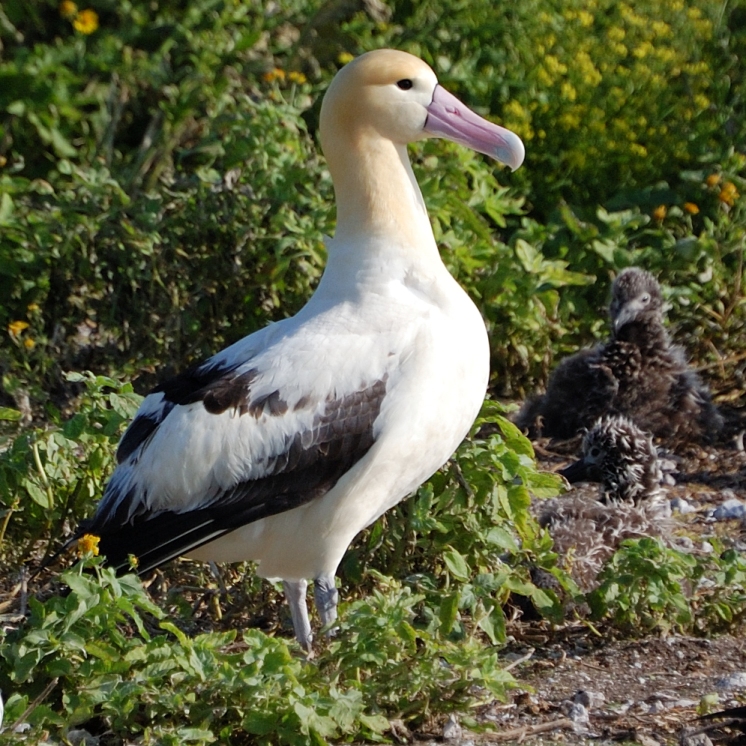|
| Query: bird | Result: 4066th of 32675 | |
Short-tailed Albatross (Phoebastria albatrus) - Wiki
| Subject: | Short-tailed Albatross (Phoebastria albatrus) - Wiki
| |

| Resolution: 746x746
File Size: 482988 Bytes
Date: 2007:03:14 10:10:47
Camera: NIKON D40 (NIKON CORPORATION)
F number: f/5.7
Exposure: 5/10000 sec
Focal Length: 185/1
Upload Date: 2007:12:14 11:38:26
|
Short-tailed Albatross
From Wikipedia, the free encyclopedia
Order: Procellariiformes
Family: Diomedeidae
[Photo] Short-tailed Albatross (Phoebastria albatrus). Taken by - James Lloyd. Place - Eastern island, Midway Atoll. March 2007. Source - http://www.pbase.com/freespirit/image/80996745 Copyright (C) 2007 James Lloyd
Permission is granted to copy, distribute and/or modify this document under the terms of the GNU Free Documentation License, Version 1.2 or any later version published by the Free Software Foundation; with no Invariant Sections, no Front-Cover Texts, and no Back-Cover Texts. A copy of the license is included in the section entitled "GNU Free Documentation License". |
The Short-tailed Albatross or Steller's Albatross (Phoebastria albatrus) is a large rare seabird from the North Pacific. Although related to the other North Pacific albatrosses, it also exhibits behavioural and morphological links to the albatrosses of the Southern Ocean. It was described by the German naturalist Peter Simon Pallas from skins collected by the intrepid Georg Wilhelm Steller (after whom its other common name is derived). Once common, it was brought to the edge of extinction by the trade in feathers, but with protection has recently made a recovery.
The Short-tailed Albatross is a large bird, with a wingspan of 2.37 m (7.9 ft), a length of 90 cm (3 ft) and a body weight of 4.3 kg (9.5 lbs). It can be distinguished from the other two species of albatross in its range, the Laysan Albatross and the Black-footed Albatross by its larger size and its pink bill (with a bluish tip), as well as details of its plumage. Contrary to its name its tail is no shorter than that of the Laysan or Black-footed, and is actually longer than that of the other member of the genus Phoebastria, the Waved Albatross. Its plumage as an adult is overall white with black wings and a yellow-stained head. The juveniles are an all-over brown colour.
Short-tailed Albatrosses nest on two islands, the Japanese islands of Minami Torishima and Minami-kojima. When at sea feeding they range across the North Pacific, particularly in the Bering Sea where the largest numbers are seen today, but also as far west as California. Historically Torishima was the most important breeding colony but they also bred on islands from Taiwan north, as well as the Bonin Islands. Going further back in time, fossils of albatrosses from the mid-Pleistocene in Bermuda and North Carolina are considered to be closest to the Short-tailed Albatross.
The Short-tailed Albatross came perilously close to extinction. They were hunted on an almost industrial scale for their feathers in the later half of the 19th century with some estimates claiming upward of 10 million birds hunted. By the 1930s the only population left was on Torishima, between 1927 and until 1933 hunting continued when the Japanese government declared the ban of hunting to save the species, after which the albatrosses stopped breeding on the island. At this point the species was assumed to be extinct and research became impossible with the outbreak of World War II. On 1949 an American researcher arriving on this island declared the species to be extinct, but an estimated 50 individuals, most likely juveniles, survived at sea (all albatross species take a long time to reach sexual maturity and will not return to their natal colony for many years). After the return of the birds they were more carefully protected, and the first egg was laid by the returning birds in 1954. Varieties of albatross decoys were placed around on the island after it was discovered that like other albatross species, this species also were enticed to breed if placed in a group. Since then with the aid of protection efforts, the population has increased to an estimated 1840 birds as of 2003.
http://en.wikipedia.org/wiki/Short-tailed_Albatross
| The text in this page is based on the copyrighted Wikipedia article shown in above URL. It is used under the GNU Free Documentation License. You may redistribute it, verbatim or modified, providing that you comply with the terms of the GFDL. |
|
^o^
Animal Pictures Archive for smart phones
^o^
|
|

